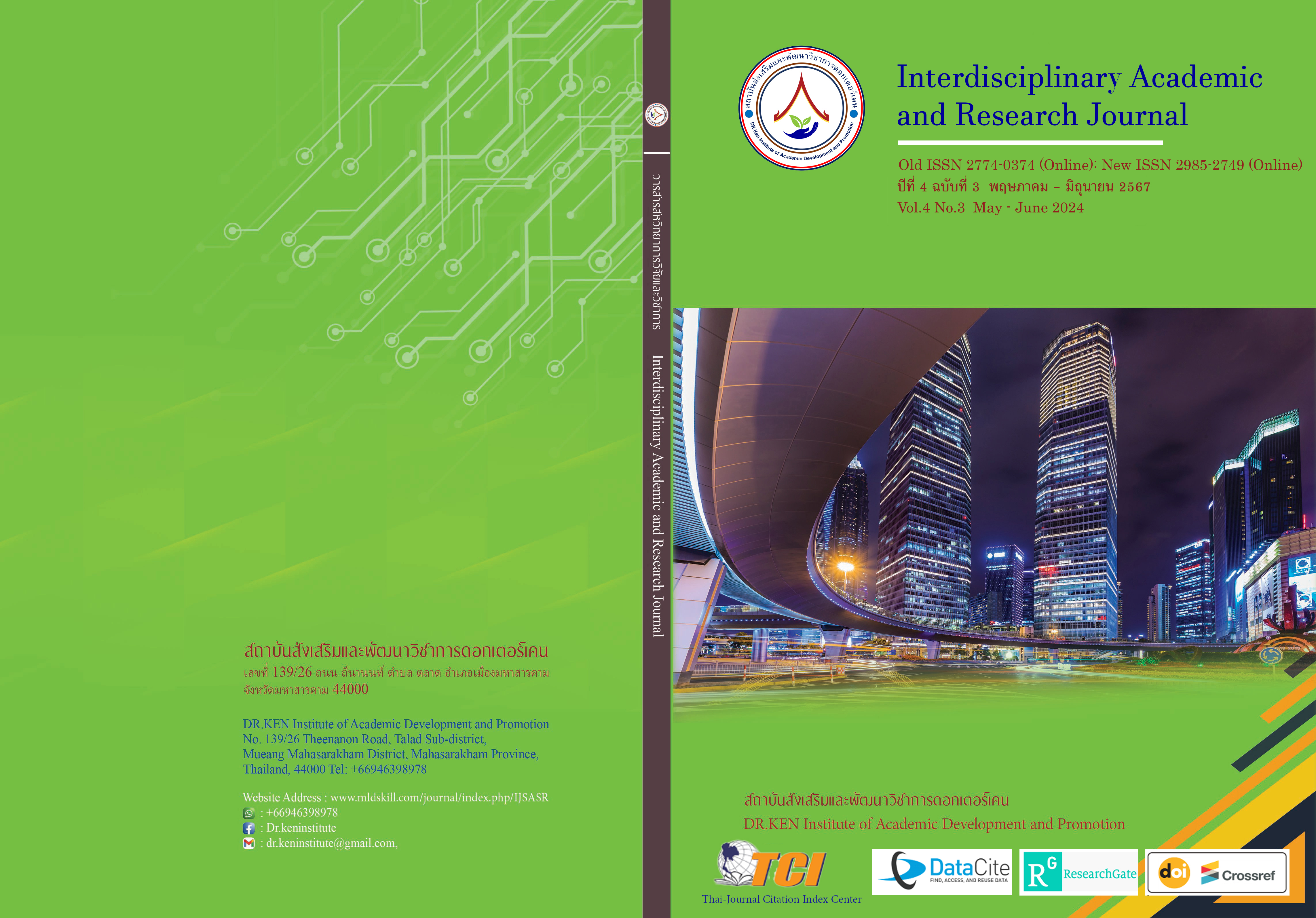A Development of Painting Curriculum Using Simson’s Practical Skills Learning Model for Grade 3 Students
DOI:
https://doi.org/10.60027/iarj.2024.275531Keywords:
Curriculum Development; , Drawing and Painting; , Simpson’s Practical Skills Learning Model; , Drawing and Painting AbilityAbstract
Background and Aims: Drawing and painting is a joy for many people. It is also a practice of visual skills. small muscles creativity and artistic skills in itself It is also a practice of relaxation and meditation. From the current problems in teaching art subjects Visual arts content From an interview with an art teacher In Grade 3, it was found that students lacked drawing and painting skills. The curriculum is therefore the heart of education. In this course, students learn according to their own needs and interests. Challenge your ability to improve your drawing and painting abilities each time with repeated practice. Until you practice it yourself with simple steps. Until able to do it expertly Able to apply and develop initiatives Imagine creating your creations. The objectives of this research were 1) create and verify the quality of development of the painting curriculum using Simpson’s practical skills learning model for grade 3 students and 2) Study the results of using the painting course using the skill learning style of Simpson’s practical skills for third graders
Methodology: The painting course uses the skill learning style of Simpson’s practical skills for third graders, which is preliminary experimental research. a pattern used in This experiment is a one-group pre-test-post-test design. The sample groups are class students 3rd year of primary school, 2nd semester of academic year 2566 B.E., Ban Pong Sanook School, Mueang District, Province Lampang, Lampang Primary Educational Service Area Office 1, totaling 42 people, which was obtained randomly. (Cluster Random Sampling) Research tools include Courses and manuals. The ability to paint test had a difficulty value was 0.80. The discrimination value was 0.21. The reliability value was 0.86, and the statistics used in data analysis are Average, percentage, standard deviation, and t-test dependent.
Results: The research found that the development of a painting curriculum using Simpson’s practical skills learning model for grade 3 students has 7 elements 1) Background 2) Principles 3) objectives 4) the content in the curriculum consisting of 5 units (1) The Beautiful Flower (2) The Happy in my home (3) The Cute Earth Animals (4) The round face child (5) Favorite Items 5) Learning Activity Process 6) Learning ais/sources 7) assessment and evaluation. And the overall curriculum guidelines are most appropriate. After utilizing the development of the painting curriculum using Simpson’s practical skills learning model for grade 3 students it was found that The ability to draw and paint post-test was statistically significantly higher than pre-test at .05.
Conclusion: Drawing and painting course using Simpson's practical skills learning model. For Grade 3 students, this is an appropriate learning method that will enhance learning efficiency in art subjects. Visual arts course and develop drawing and painting skills very well. Because students learn about the needs and interests of students. Students also challenge their abilities each time by practicing repeatedly until they can progress from easy to proficient. Able to apply and develop initiatives Imagine creating your work that is different from the original. Make students happy in learning.
References
เพชรปาณี อินทรพาณิชย์ สําราญ กําจัดภัย และสมพร หลิมเจริญ. (2560). การพัฒนาหลักสูตรเสริมเพื่อเสริมสร้างทักษะการคิดวิเคราะห์ สำาหรับนักเรียน ระดับชั้นประถมศึกษาปีที่ 6 โรงเรียนอนุบาลสกลนคร. วารสารมหาวิทยาลัยนครพนม. 7 (1), 99-106.
แพรวนภา อินทสิทธิ์. (2562). การพัฒนาแบบฝึกทักษะการวาดภาพ โดยการเรียนตามหลักการของเดวีส์ร่วมกับเทคนิคการเรียนรู้เชิงประสบการณ์ ที่มีผลต่อความคิดสร้างสรรค์ ความสุขในการเรียน และความรับผิดชอบ วิชาทัศนศิลป์ ชั้นประถมศึกษาปีที่ 1. วิทยานิพนธ์ปริญญาครุศาสตรมหาบัณฑิต สาขาวิชาการวิจัยและพัฒนาการศึกษา : มหาวิทยาลัยราชภัฏสกลนคร.
กรมวิชาการ. (2540). แนวทางการสอนที่เน้นทักษะกระบวนการ. กรุงเทพฯ : โรงพิมพ์คุรุสภาลาดพร้าว.
กระทรวงศึกษาธิการ. (2551). หลักสูตรแกนกลางการศึกษาขั้นพื้นฐาน พุทธศักราช 2551. กรุงเทพฯ : โรงพิมพ์คุรุสภาลาดพร้าว.
กุลนิดา เหลือบจำเริญ. (2553). องค์ประกอบศิลป์. ปทุมธานี: สกายบุ๊กส์ จำกัด.
ขวัญชนก โพธิ์ศรี และ ปฤณัต นัจนฤตย์. (2565). การพัฒนาแบบฝึกทักษะการระบายสีไม้ด้วยเทคนิค 5’S สำหรับนักเรียนชั้นประถมศึกษาตอนต้นโรงเรียนชุมทางตลิ่งชัน. วารสารศึกษาศาสตร์ มหาวิทยาลัยศิลปาก. 20 (1), 190-202.
จันทรรัตน์ จาดแห และปริญญภาษ สีทอง. (2565). การพัฒนาหลักสูตรส่งเสริมความสามารถในการอ่านจับใจความสำคัญ โดยใช้กลวิธีการสอนแบบดี อาร์ ที เอ สำหรับนักเรียนชั้นประถมศึกษาปีที่ 3. วารสาร มจร บาฬีศึกษาพุทธโฆสปริทรรศน์. 8 (1), 153-164.
ชลูด นิ่มเสมอ. (2553). สายธารแห่งชีวิต (STREAM OF LIFE) - วาดเส้น (Drawing). กรุงเทพฯ: บริษัทอมรินทร์พริ้นติ้งแอนด์พับลิชชิ่ง.
ชวลิต ชูกําแพง. (2551). การพัฒนาหลักสูตร. มหาสารคาม: ทีคิวพี จํากัด.
ชัยวัฒน์ สุทธิรัตน์. (2564). การพัฒนาหลักสูตร ทฤษฎีสู่การปฏิบัติ. นนทบุรี : เอ็มดี ออล กราฟิก.
ณัชณิชา โพธิ์ใจ และวารีรัตน์ แก้วอุไร. (2562). การพัฒนาหลักสูตรเสริมสร้างคุณลักษณะด้านความรับผิดชอบตามแนวคิด คุณลักษณะศึกษาของลิคโคนา สำหรับนักเรียนชั้นมัธยมศึกษาตอนต้น. วารสารศึกษาศาสตร์มหาวิทยาลัยนเรศวร. 21 (3), 61-74.
ทิศนา แขมมณี. (2552). ศาสตร์การสอน. พิมพ์ครั้งที่ 5. กรุงเทพฯ : ด่านสุทยาการพิมพ์จํากัด
นิฤมล โนวิชัยและปริญญภาษ สีทอง. (2565). การพัฒนาหลักสูตรส่งเสริมความสามารถการเขียนเรื่องตามจินตนาการโดยใช้แผนภาพ โครงเรื่องร่วมกับการให้ข้อมูลย้อนกลับสำหรับนักเรียนชั้นประถมศึกษาปีที่ 3. วิทยานิพนธ์มหาบัณฑิต สาขาวิชาหลักสูตรและการสอน : มหาวิทยาลัยราชภัฏลำปาง.
สุธน วงค์แดง ภาณุมาส เศรษฐจันทร และวีระพงษ์ สิงห์ครุฑ. (2561). การพัฒนาหลักสูตรฝึกอบรมเพื่อเสริมสร้างทักษะการเรียนรู้ในศตวรรษที่ 21 สำหรับนักศึกษาครู มหาวิทยาลัยราชภัฏกลุ่มรัตนโกสินทร. วารสารวิชาการและวิจัยสังคมศาสตร์. 13 (37), 75-87.
อนุตรา สุวคันธกุล. (2564). การพัฒนาทักษะสีน้ำ วิชาศิลป์จินตนาการ โดยใช้กระบวนการเรียนการสอนตามแนวคิดการพัฒนาทักษะปฏิบัติของซิมพ์ซัน. ปริญญานิพนธ์การศึกษามหาบัณฑิต สาขาวิชาศิลปศึกษา :มหาวิทยาลัยศรีนครินทรวิโรฒ.
Oliva, Peter F. (1992). Developing the Curriculum. 3rd edition. New York: HarperCollins.
Taba, H. (1962). Curriculum development: theory and practice. New York, NY: Harcourt, Brace & World.
Downloads
Published
How to Cite
Issue
Section
License
Copyright (c) 2024 Interdisciplinary Academic and Research Journal

This work is licensed under a Creative Commons Attribution-NonCommercial-NoDerivatives 4.0 International License.
Copyright on any article in the Interdisciplinary Academic and Research Journal is retained by the author(s) under the under the Creative Commons Attribution-NonCommercial-NoDerivatives 4.0 International License. Permission to use text, content, images, etc. of publication. Any user to read, download, copy, distribute, print, search, or link to the full texts of articles, crawl them for indexing, pass them as data to software, or use them for any other lawful purpose. But do not use it for commercial use or with the intent to benefit any business.
















.png)


